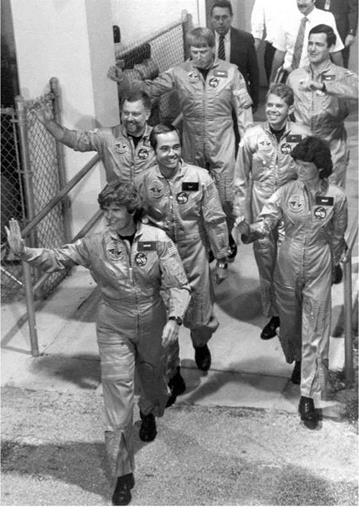STS 41-G
|
Int. Designation |
1984-108A |
|
Launched |
4 October 1984 |
|
Launch Site |
Pad 39A, Kennedy Space Center, Florida |
|
Landed |
13 October 1984 |
|
Landing Site |
Runway 33 North, Kennedy Space Center, Florida |
|
Launch Vehicle |
OV-099 Challenger/ET-15/SRB A63; A64/SSME #1 2023; #2 2020; #3 2021 |
|
Duration |
8 days 5 hrs 23 min 38 sec |
|
Callsign |
Challenger |
|
Objective |
Satellite deployment mission; Space Imaging Radar experiments; satellite refuelling demonstration |
Flight Crew
CRIPPEN, Robert Laurel, 47, USN, commander, 4th mission Previous missions: STS-1 (1981); STS-7 (1983); STS 41-C (1984) MCBRIDE, Jon Andrew, 41, USN, pilot
RIDE, Sally Kristen, 33, civilian, mission specialist 1, 2nd mission Previous mission: STS-7 (1983)
SULLIVAN, Kathryn Dwyer, 32, civilian, mission specialist 2 LEESTMA, David Cornell, 35, USN, mission specialist 3 SCULLY-POWER, Paul Desmond, 40, USN, payload specialist 1 GARNEAU, Marc, 35, Canadian Navy, payload specialist 2
Flight Log
Bob Crippen, the first astronaut to fly four Shuttle missions, was specially selected to command this mission to evaluate the effectiveness of flying two missions close together (he had commanded STS 41-C six months before). The main reason was to determine the feasibility of recycling complete Shuttle flight crews to minimise training time and free up limited simulators and resources as Shuttle flight rates increased. Delayed from 1 October, the launch at 07: 03 hrs on 4 October was early enough to create spectacular colour schemes as Challenger punched a hole in the cloud-filled sky as it headed for its 57° orbit and a maximum altitude of 304 km (189 miles). The scientific mission was almost thrown into disarray immediately when the satellite part of the Earth Radiation Budget Experiment project, ERBE, misbehaved prior to deployment. Computer software errors and the failure of the satellite’s solar panels combined to foil the mission specialists, until Ride got hold of ERBE with the RMS robot arm and shook it. The panel unfolded and the satellite was deployed to begin its work.
|
Clockwise from top left, the STS 41-G crew of McBride, Garneau, Leestma, Ride, Sullivan, Crippen and Scully-Power heads for the launch pad |
Then a Shuttle Imaging Radar, SIR-B, antenna panel failed to deploy and Challenger’s Ku-band antenna failed to lock into position, making it impossible to send SIR data real-time. The crew performed some electronic troubleshooting, locking the antenna into one position, enabling about 40 per cent of SIR data to be relayed in realtime. These images were of such clarity that many were impounded temporarily by the Department of Defense. During their 3 hour 27 minute EVA on 11 October, Leestma (EV1) and Sullivan (EV2) practised an in-orbit refuelling technique, preparing the transfer of highly dangerous hydrazine propellant between two containers before entering the orbiter to monitor events from relative safety.
The first Canadian in space, Marc Garneau, operated a suite of ten experiments, labelled CANEX (Canadian Experiments), that focused on space technology, Earth and space sciences. Australian born, and US naturalized oceanographer Paul Scully – Power was flying for the US Navy to conduct real-time observations of ocean phenomena from space.
After a re-entry over the east coast of the USA for the first time, Challenger made a 384 kph (239 mph) landing at runway 33 North at the Kennedy Space Center, with main gear touchdown at 8 days 5 hours 23 minutes 33 seconds, and a 3,220 m (10,564 ft) 59-second rollout. After the mission, the longest by seven crew, it was found that Challenger could have met with disaster during re-entry. Over 4,000 heatshield tiles were found to be loose, their adhesive weakened by a new injection waterproofing technique.
Milestones
101st manned space flight
44th US manned space flight
13th Shuttle mission
6th flight of Challenger
1st flight with seven crew members
1st manned space flight by a Canadian
1st flight with two female crew members
1st US male-female EVA
19th US and 28th flight with EVA operations











